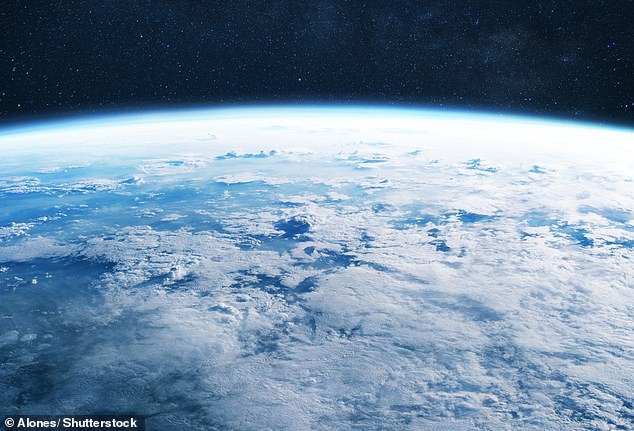Scientists have stunned the world with the news that life likely does exist on a faraway planet.
K2-18b – which is more than twice as big as Earth and 120 light-years away – sits within the habitable zone of its star in the Leo constellation.
According to a new University of Cambridge study, its atmosphere contains huge quantities of chemicals, which on Earth are only made by living organisms.
Planet K2-18b is a suspected a ‘hycean’ world – a rocky planet with a hydrogen-rich atmosphere and vast oceans of water.
It’s probable that K2-18b’s oceans are filled with something like phytoplankton – tiny organisms that feed on the energy from the nearby star.
But what’s exciting is that K2-18b is very unlikely to be a one-off in the universe – meaning many others that are similar likely exist too.
Peter Vickers, a philosophy of science professor at Durham University, said there are likely ‘millions’ of planets outside our galaxy hosting some kind of lifeforms.
‘If it does turn out that K2-18b has life, then it is virtually guaranteed that there are million more exoplanets harbouring extraterrestrial life,’ he told MailOnline.

Planet K2-18b is a suspected a ‘hycean’ world – a rocky planet with a hydrogen-rich atmosphere and vast oceans of water (artist’s impression)

But what’s exciting is that K2-18b is very unlikely to be a one-off in the universe – meaning many others like it likely exist
Professor Vickers added: ‘Hundreds of millions is pretty safe estimate and not overblown.’
Planet K2-18b is in the same galaxy as us – the Milky Way – but there are billions to trillions of estimated galaxies in the universe.
The academic stressed that we’ve only sampled a ‘tiny, tiny percentage of planets’ in our galaxy alone, using various space and Earth-based telescopes.
So the universe as a whole surely has many more planets waiting to be found that have conditions right for life to thrive.
‘It would be like dipping a cup at random in an ocean and getting a fish, and then asking the question whether there are probably lots of other fish in the ocean, he said.
And if you think biological activity does exist out there in the vast reaches of space, the likelihood is that experts in the field would agree with you.
A survey by Professor Vickers and colleagues conducted last year suggests this is the general consensus among astrobiologists (scientists who study extraterrestrial life).
Out of 521 astrobiologists who responded, 86.6 per cent agreed or strongly agreed it’s likely that extraterrestrial life (of at least a basic kind) exists somewhere in the universe, while less than 2 per cent disagreed and 12 per cent were neutral.

On Earth, DMS and DMDS are only produced by living organisms – mostly microbial life such as marine phytoplankton (like the ones pictured). Life on K2-18b could be similar

No life beyond Earth has ever been found and there is no evidence that alien life has ever visited our planet. But this may be due to extraterrestrial life being too scared of ‘dangerous’ and ‘violent’ humans (artist’s impression of the typical ‘alien’ concept)
What’s more, 88.4 per cent of non-astrobiologists agreed – showing astrobiologists aren’t biased toward believing in extraterrestrial life compared with other scientists.
‘So, based on this, we might say that there’s a solid consensus that extraterrestrial life, of some form, exists somewhere out there,’ said Professor Vickers and colleagues in a piece for The Conversation.
British science writer and biologist Matthew Ridley believes it would be ‘fairly bizarre’ if Earth was the only planet in the universe with life on it.
‘Given the scale of the universe, it would be more surprising if life did not exist in it,’ he says in today’s Daily Mail.
‘If [life] started billions of years earlier on other planets, then it is probable that it has had time to generate not just microbes and algae, but technology-generating beings too, and probably super-intelligent ones.’
However, Viscount Ridley said perhaps ‘we should keep quiet and not let the aliens know we exist’ in case our planet is destroyed or conquered.
Mark Buchanan, a physicist and science writer, also thinks there are many more exoplanets like K2-18b that harbor similar lifeforms.
‘It’s only in the past decade or so that our telescopes have become powerful enough to find and examine planets orbiting other stars,’ Buchanan told MailOnline.

Using data from the James Webb Space Telescope (JWST), astronomers identified huge quantities of chemicals only made by living organisms on Earth. They have picked up the chemical fingerprints of dimethyl sulfide (DMS) and dimethyl disulfide (DMDS) – molecules that are primarily produced by microbial life such as marine phytoplankton
‘Plausible estimates put the number of potentially life supporting planets in the hundreds of millions or more.
‘The universe really is a big place and we’re just beginning to explore what is out there.’
Buchanan called the new announcement from University of Cambridge scientists a ‘fascinating finding’ as it suggests there’s ‘more advanced life forms elsewhere’.
The new findings provide the ‘strongest hint yet’ of biological activity outside our solar system according to the researchers – although they are yet to be definitively confirmed.
This article was originally published by a www.dailymail.co.uk . Read the Original article here. .


